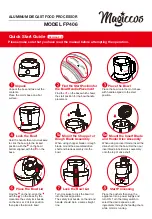
The Cortex-M4 Instruction Set
ARM DUI 0553A
Copyright © 2010 ARM. All rights reserved.
3-98
ID121610
Non-Confidential
3.7.3
QADD and QSUB
Saturating Add and Saturating Subtract, signed.
Syntax
op{
cond
} {
Rd
},
Rn
,
Rm
op{
cond
} {
Rd
},
Rn
,
Rm
where:
op
Is one of:
QADD
Saturating 32-bit add.
QADD8
Saturating four 8-bit integer additions.
QADD16
Saturating two 16-bit integer additions.
QSUB
Saturating 32-bit subtraction.
QSUB8
Saturating four 8-bit integer subtraction.
QSUB16
Saturating two 16-bit integer subtraction.
cond
Is an optional condition code, see
.
Rd
Specifies the destination register.
Rn, Rm
Are registers holding the first and second operands.
Operation
These instructions add or subtract two, four or eight values from the first and second operands
and then writes a signed saturated value in the destination register.
The
QADD
and
QSUB
instructions apply the specified add or subtract, and then saturate the result to
the signed range
−
2
n
–1
≤
x
≤
2
n
–1
−
1, where
x
is given by the number of bits applied in the
instruction, 32, 16 or 8.
If the returned result is different from the value to be saturated, it is called
saturation
. If
saturation occurs, the
QADD
and
QSUB
instructions set the Q flag to 1 in the APSR. Otherwise, it
leaves the Q flag unchanged. The 8-bit and 16-bit
QADD
and
QSUB
instructions always leave the Q
flag unchanged.
To clear the Q flag to 0, you must use the
MSR
instruction, see
.
To read the state of the Q flag, use the
MRS
instruction, see
Restrictions
Do not use SP and do not use PC
.
Condition flags
These instructions do not affect the condition code flags.
If saturation occurs, these instructions set the Q flag to 1.
















































